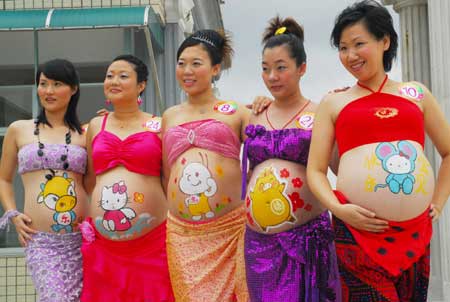| Home > Living in China > Art |
Chinese ancient officials and their scrolls
|
|
BEIJING, Oct. 30 -- Bamboo strips were used widely for writing during the Warring States Period (475-221 BC), although some experts say the first scrolls of bamboo appeared in the Western Zhou Dynasty (11th century-771 BC). Paper finally replaced bamboo as the primary writing material around the 2nd century. It was a finding in Xi'an, Shaanxi province that shed light on how bamboo strips had been used 2,200 years ago.
In 2001, archaeologists made an important discovery near the mausoleum of Emperor Qinshihuang - the First Emperor of the Qin Dynasty (221-206 BC) - in Lintong county, Xi'an, in Northwest China.
Among the 12 life-sized figures that were unearthed, experts were astonished to see eight civil officials. Standing 1.89 m tall, they all wore tall headdresses tied to the chin. Their long robe was bound with a leather belt, and they were all dressed in long trousers and square-shaped shoes. The other four figures, 1.9 m tall, were chariot drivers.
Ever since farmers chanced upon the first Terracotta Warriors about 15 km away from the mausoleum in 1974, archaeologists have been puzzled by one question: Since the First Emperor's mausoleum was laid out like Xianyang, the capital of the Qin Dynasty, how could it have only troops but no civil officials, who were indispensable to any imperial court?
The discovery in 2001 answered that question, and researchers believe the eight figures were modeled after officials with the Central Bureau who served the First Emperor.
The researchers were fascinated by these figures who all look respectful with their eyes looking down. On one side of their belt hangs a pocket knife and they carry a grindstone on the back. In their left armpit is a scroll of bamboo strips.
Experts say this strange outfit is linked to the founding of the Qin Empire.
In 221 BC, Ying Zheng, then the Duke of Qin, united the six warring dukedoms to found the Qin Dynasty, the first centralized feudal empire in Chinese history. As the First Emperor, Ying Zheng ordered that laws, measurements and currencies be unified. Three dukes and nine imperial ministers formed the Central Bureau to deal with national affairs.
But in the process of writing down documents, many officials found it very inconvenient to use the different written characters left by the six former dukedoms. The confusion in writing caused havoc in communication and even threatened the throne.
Li Si, chief imperial minister, suggested that the written characters be standardized. The Emperor ordered that all written documents adopt the xiaozhuan style of writing formerly used in the Dukedom of Qin.
It was exhausting to engrave the documents on bamboo strips. After Li Si made comments on a document, it would be sent to the civil officials, who would carefully read the texts and scrape off the words that didn't match the standardized style. After that, they would engrave the correct words on the bamboo strips.
The officials would use the pocket knife to take off the wrong words. As they used the knives so often, they had to sharpen the blade from time to time. Thus, many civil officials carried the grindstone on their back to save time. Before long, it became fashionable for civil officials to carry a pocket knife and grindstone.
Since the figures all had tall headdresses, experts say they must have been the top-ranking civil officials. Most probably, it was these officials who scraped off the wrong characters on bamboo strips so that the standardized writing could spread throughout the empire.
By the Han and Wei dynasties a few centuries later, the written characters would develop from xiaozhuan to kaiti, which would form the basis of written Chinese characters for thousands of years to come.
Art
 more
more[Photo] China National Opera House
Chinese soprano Wang Xia perfoms her part in the world

[Photo] Nannning International
Actresses perform acrobatics during a performance

"Peony Pavilion" staged on
Dance drama "Peony Pavilion" is staged at the Shanghai

Customs
 more
more



 print
print  email
email  Favorite
Favorite  Transtlate
Transtlate 

